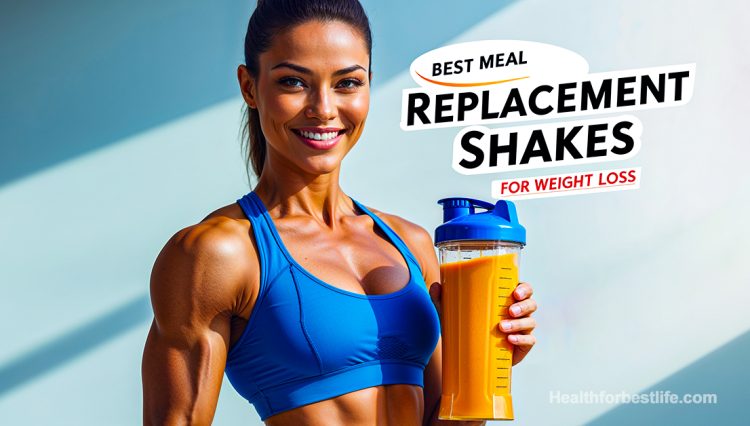The Ultimate Guide to Finding the Best Meal Replacement Shakes for Weight Loss
Let’s be real—shedding pounds isn’t easy. Between busy schedules and cravings, sticking to a diet feels like a uphill battle. That’s why meal replacement shakes have exploded in popularity. They’re not magic potions, but when used right, they can simplify calorie control and keep you on track. Whether you’re rushing out the door or need a post-gym refuel, this guide breaks down everything you need to know about using shakes to hit your weight loss goals.
We’ll dive into how they work, what to look for, top picks for every budget, and even tackle common myths. No fluff, just straight talk to help you make smart choices.

Meal Replacement Shakes 101: What Are They?
Think of these shakes as your nutrition wingman. They’re designed to swap out a full meal while packing protein, fiber, vitamins, and minerals into a low-calorie drink. Unlike that sad desk salad or greasy takeout, a good shake keeps you full without the guesswork. Many now include extras like probiotics for gut health or superfoods like chia seeds. The best part? They’re idiot-proof. No measuring, no cooking—just grab, shake, and go.
Why They Work for Weight Loss
- Portion Control Built-In: Every sip has a fixed calorie count, so you’re not accidentally overeating.
- Nutrients Over Junk: You get what your body needs—not just empty carbs.
- Lazy-Proof Convenience: Perfect for mornings when hitting snooze wins over cooking eggs.
But here’s the kicker: They’re not a free pass to skip real food forever. Use them as a tool, not a crutch.
The Science Behind Shakes and Shedding Pounds
Weight loss boils down to calories in vs. calories out. Most shakes clock in at 200–400 calories—way less than a typical 600-calorie lunch. By swapping one meal daily, you create a deficit without feeling starved. Here’s why they’re effective:
- Protein Power: Shakes with 20–30g of protein curb hunger and protect muscle (key for burning fat).
- Sugar Smarts: Skip shakes loaded with sugar—they’ll spike cravings. Go for ones sweetened with stevia or monk fruit.
- Fiber Fix: Ingredients like oats or acacia fiber slow digestion, keeping you satisfied longer.
Example: Swap a fast-food burger (700+ calories) for a 300-calorie chocolate shake. Do that daily, and you’ll drop pounds without the burger regret.

Ingredients That Matter (And Red Flags to Avoid)
Don’t fall for fancy marketing. Flip that bottle and read the label. Here’s what to hunt for:
Must-Haves
- Protein Source: Whey, pea, or collagen—pick what suits your diet.
- Healthy Fats: MCT oil or avocado keeps energy steady.
- Fiber: Aim for 5–10g per shake to avoid snack attacks.
- No Junk: Steer clear of artificial sweeteners like sucralose or fillers like maltodextrin.
Skip These
- Sugar Bombs: If sugar’s in the top 3 ingredients, put it back.
- Chemical Cocktails: Ingredients you can’t pronounce? Hard pass.
Top Shakes Worth Your Money
- SlimFast Optima: Cheap, cheerful, and comes in flavors like caramel latte. Great for newbies.
- Huel Black Edition: Vegan, 40g of protein, and tastes like a milkshake (seriously).
- Orgain Organic: Clean ingredients, 20g plant protein, and ideal for sensitive stomachs.
- Premier Protein Café Latte: 30g protein + caffeine hit = breakfast MVP.
- Ample Keto: For low-carb diehards—packed with fats and only 4g net carbs.
Pro Tip: Sample single-serving packs before committing to a tub. Your taste buds will thank you.
How to Use Shakes Without Getting Bored
Rule #1: Don’t replace all meals. Start with one (breakfast is easiest). Pair your shake with a banana or handful of almonds for crunch.
Blend Hacks:
- Add frozen berries + spinach for a vitamin boost.
- Mix coffee + chocolate protein shake for a mocha fix.
- Throw in PB2 powder for peanut butter flavor without the calories.
Timing Matters: Drink post-workout to refuel muscles or as a mid-afternoon slump buster.

The Dark Side: Potential Pitfalls
Overdoing shakes can backfire. Watch for:
- Tummy Trouble: Too much fiber too fast = bloating. Ease into it.
- Missing Nutrients: Long-term shake-only diets lack phytonutrients from veggies.
- Mindless Sipping: Shakes aren’t snacks. Stick to meal times.
Fix: Use shakes 1–2 meals max, and eat whole foods rich in veggies, lean meats, and whole grains otherwise.
Calorie Deficit Made Simple
To lose weight, you must burn more than you eat. Calculate your TDEE (Total Daily Energy Expenditure) using an online calculator. Subtract 300–500 calories for steady loss. Shakes make hitting that number easier—no apps or food scales needed.
Example: If your TDEE is 1,800, a 300-calorie shake for lunch leaves room for a hearty 500-cal dinner.
Vegan vs. Whey: Which Wins?
Vegan Shakes (Pea/ Hemp Protein):
- Easier on digestion
- Eco-friendly
- Often include greens like spirulina
Whey-Based Shakes:
- Faster muscle recovery post-workout
- Creamier texture
- Usually cheaper
Pick based on your dietary vibe. Both work if protein content is solid.
Busting Myths Like a Pro
Myth 1: “Shakes are for lazy dieters.”
Truth: Busy parents, athletes, and CEOs use them. It’s about efficiency, not laziness.
Myth 2: “They taste like chalk.”
Truth: 2024’s options include birthday cake and cookies & cream flavors.
Myth 3: “You’ll lose muscle.”
Truth: High-protein shakes preserve muscle. Skipping protein is what wastes it.

Shakes on a Budget
- DIY It: Blend oats, protein powder, almond milk, and frozen fruit. Cheaper than premade.
- Subscribe & Save: Amazon or brand sites often offer 15–20% off subscriptions.
- Store Brands: Walmart’s Equate or Target’s Simply Balanced offer dupes for half the price.
Long-Term Game Plan
Shakes aren’t forever. Once you’re near your goal, phase them out:
- Week 1–4: 2 shakes daily
- Week 5–8: 1 shake + balanced meals
- Week 9+: Shakes only for emergencies (like airport food deserts).
The Fiber Factor
Most of us barely hit half our daily fiber needs (25–30g). A shake with 8g fiber = ⅓ of your goal. Look for shakes with chicory root or psyllium husk—gentler on digestion than some fibers.
Flavor Fatigue Fixes
Rotate flavors weekly. Monday: vanilla. Tuesday: salted caramel. Add spices (cinnamon, nutmeg) or a dash of hot sauce (trust us) to keep things weird.
Eco-Friendly Options
- Sustainability Stars: Huel uses recyclable packaging. Garden of Life’s bottles are plant-based.
- DIY Saves Waste: Make batches in a mason jar instead of single-use bottles.

Shakes for Every Diet
- Keto: Ratio Keto has 75% fat, 2g net carbs.
- Paleo: PaleoPro uses egg-white protein + coconut.
- Gluten-Free: Ensure Max Protein is certified GF.
Pair Shakes with Sweat
For best results, mix shakes with:
- Strength Training: 3x weekly to build metabolism-boosting muscle.
- Walks: 30 minutes daily to torch extra 150–200 calories.
Final Word
Meal replacement shakes aren’t a fairy tale solution, but they’re a legit tool. Choose wisely, stay consistent, and remember—real food still rules. Use shakes to simplify the grind, not replace it entirely.
Now, go grab a shaker bottle and make that weight loss journey a little less chaotic. You’ve got this.

